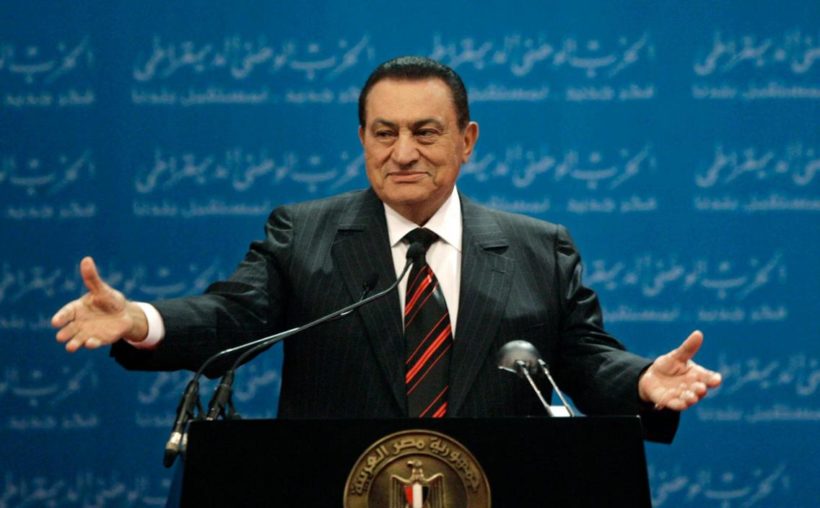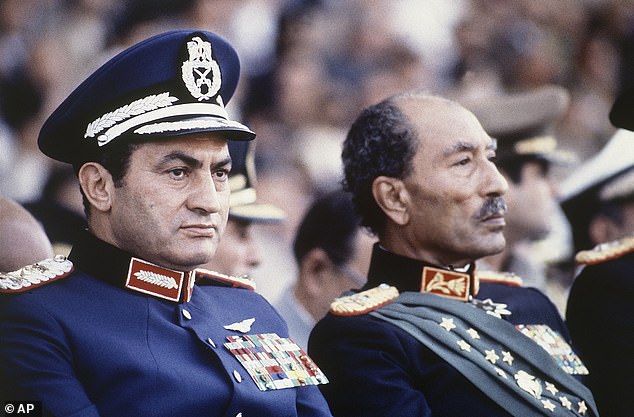
Former Egyptian President Hosni Mubarak delivers a speech in Cairo in 2008.
redo Jump to...
print Print...
(by CBS News from an AP report) Cairo — President Hosni Mubarak, the Egyptian leader who for nearly 30 years was the resolute face of stability in the Middle East, died on Tuesday, the country’s state television said, ending his days after a swift and ignominious tumble from power in the Arab world’s pro-democracy upheaval [known as the Arab Spring]. He was 91.
Throughout his rule, he was a stalwart U.S. ally, a bulwark against Islamic militancy and guardian of Egypt’s peace with Israel. But to the tens of thousands of young Egyptians who rallied for 18 days of unprecedented street protests in Cairo’s central Tahrir Square and elsewhere in 2011, Mubarak was a relic, a latter-day pharaoh.
They were inspired by the Tunisian revolt, and harnessed the power of social media to muster tumultuous throngs, unleashing popular anger over the graft and brutality that shadowed his rule.
In the end, with millions massed in Cairo’s Tahrir Square and city centers around the country and even marching to the doorstep of Mubarak’s palace, the military that long nurtured him pushed him aside on Feb. 11, 2011. The generals took power, hoping to preserve what they could of the system he headed.
Though Tunisia’s president fell before him, the ouster of Mubarak was the more stunning collapse in the face of the Arab Spring shaking regimes across the Arab world.
He became the only leader so far ousted in the protest wave to be imprisoned. He was convicted along with his former security chief on June 2012 and sentenced to life in prison for failing to prevent the killing of some 900 protesters during the 18-day who rose up against his autocratic regime in 2011. Both appealed the verdict and a higher court later cleared them in 2014.
The acquittal stunned many Egyptians, thousands of whom poured into central Cairo to show their anger against the court.
Published by CBS .com on Feb. 25, 2020 at 6:37 a.m. from an Associated Press report. Reprinted here for educational purposes only. May not be reproduced on other websites without permission from CBS News.
Questions
NOTE: Before answering the following questions, read the info under “Background” and watch the videos under “Resources” below.
1. List the who, what, where and when of the news report
2. For how many years did Hosni Mubarak rule Egypt?
3. When/why was Mubarak ousted?
4. How does the Associated Press reporter describe Mubarak?
5. Ask a parent what he/she remembers about Mubarak.
Background
From a Feb. 25 Associated Press report at NY Post:
Over the years, Mubarak had tinkered with reform but shunned major change, presenting himself as Egypt’s sole protection against Islamic militancy and sectarian division. The U.S. tried pushing him harder for reform, but succeeded only in alienating him. Fearful of losing its alliance with the most powerful Arab country, Washington backed off.
But the failure to fulfill repeated promises of change steadily deepened public despair, and those seeking a democratic future were dismayed to see Mubarak making apparent moves to set up a dynastic succession in the shape of his businessman son, Gamal Mubarak.
Hosni Mubarak, born in May 1928, was vice president on Oct. 14, 1981, when his mentor, President Anwar Sadat, was assassinated by Islamic extremists while reviewing a military parade. Seated next to Sadat, Mubarak escaped with a minor hand injury as gunmen sprayed the reviewing stand with bullets. Eight days later, the brawny former air force commander was sworn in as president, promising continuity and order.
UK Daily Mail:
- Following Anwar Sadat’s assassination, Mubarak became president. Over the next three decades, as the region was convulsed by one crisis after another, Mubarak was seen as a steady hand and a reliable U.S. partner against Islamic extremism.
- He sent troops as part of the U.S.-led coalition in the 1990-1991 Gulf war and contributed to efforts to resolve the Israeli-Palestinian conflict.
- Within Egypt he presided over slow but steady economic growth and largely kept the country out of armed conflicts after decades of war with Israel.
- Unlike his predecessors, both Sadat and Egypt’s first modern president, Gamal Abdel Nasser, Mubarak pursued no grand ideology beyond stability and economic development
- Over the years, Mubarak tinkered with reform but shunned major change, presenting himself as Egypt’s sole protection against Islamic militancy and sectarian division.
- The U.S., particularly under President George W. Bush, pressed for democratic reforms but was wary of alienating a key ally.
- The failure to fulfill repeated promises of change steadily deepened public despair. Those seeking a democratic future were dismayed to see Mubarak making apparent moves to groom his businessman son, Gamal Mubarak, for a dynastic succession.
- After taking power he took care to maintain Sadat’s unpopular peace deal with Israel and ruled through absolute power, keeping the country under emergency law throughout his presidency.
- He insisted on his strongman approach, which earned him the nickname the ‘Last Pharaoh’, as a way to combat terrorists in Egypt.
Read a Daily News Article from Jan. 27, 2011, just before Mubarak was ousted: “Police and Anti-Government Protesters Clash in Egypt”
Daily “Answers” emails are provided for Daily News Articles, Tuesday’s World Events and Friday’s News Quiz.




